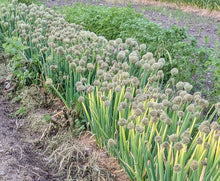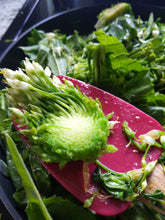Welsh Onion
Regular price
$4.00
Sale
Allium fistulosum
Origin: Eurasia
Improvement status: Landrace
Seeds per packet: ~150
Germination tested 09/2025: 98%
Life cycle: Perennial
Perhaps the most useful perennial onion, Welsh onion (Allium fistulosum) is a must-have for every perennial vegetable patch. So many perennial vegetables are limited in their harvest window or overall usefulness, but this plant offers something in almost every season. Given its early harvest and abundant yields, this plant lends itself well to market gardeners. The ecological service, culinary usefulness and ornamentality of this plants can’t be overemphasized.
On the highly diverse Montana farm where these seeds were grown (by Michael Billington), the honeybees harvest the nectar of Welsh onion more aggressively than any other crop around. Bees and other pollinators are practically magnetized to the easily accessed rich nectar deposits on the large and tightly packed head of florets. During peak bloom, the flowerheads look like a writhing mass of pollinators. Eventually, Welsh onions grow baseball-sized spherical flowerheads that look like they belong in a cottage flower garden.
In the spring, Welsh onion provides scallion greens and winter sweetened bulbs with a creamy texture. This crop is typically the first yield of the year, around April 15th in Zone 5b. With the aid of season-extension (row covers, high tunnel, etc) Michael begins his harvest in Montana on March 1st! This first onion harvest occurs in tandem with his seakle shoots and lovage Combined, these three early crops are the perfect remedy for a kitchen that has spent a winter deprived of fresh greens. In warmer climates, Welsh onion can provide food year-round. The large fleshy late spring leaf is also well suited to mincing finely and dehydrating with salt (give the dried salty greens a quick zip in the blender to break the mixture up, and this onion salt will become a staple cooking ingredient in your kitchen, especially if blended with lovage salt!). In summer, once the flowerheads set petals, prepare for a culinary bombshell. Fry them, toss them in soups, mince them and drop them into scrambled eggs or salads (flowerheads are the unsung hero of the whole Allium family). Once the flowerhead matures, it will develop fleshy triangular seed pods. The crunchy burst of texture and the ensuing deluge of onion juices can make a last minute dinner taste like an artisanal masterpiece.
GROWING TIPS: It works well to plant seed into plugs in early spring so that they can develop in size prior to being planted outside. Plant out the plugs with 4-6” spacing in a row or on a grid. These plants grow tightly and can become difficult to weed, so a dense layer of fine mulch of shredded leaves or sawdust is very helpful for weed suppression. Once established, these plants multiple vigorously. You can expect each bulb to multiply by 2 - 5x each year. It is thus advisable to harvest regularly to maintain spaciousness within your planting, otherwise you can eventually expect smaller bulbs, leaves and flowers.




